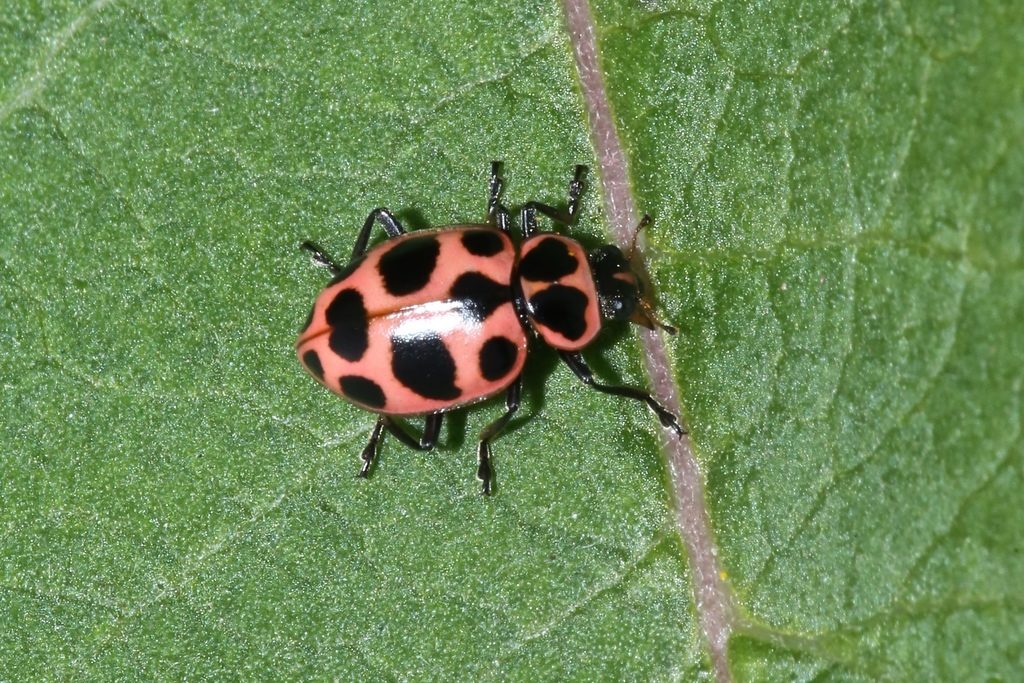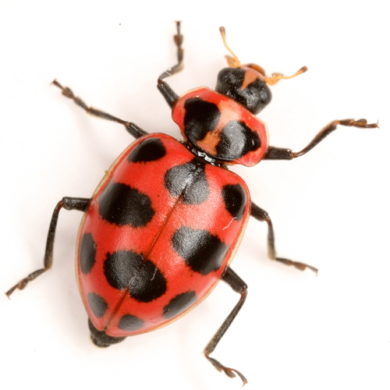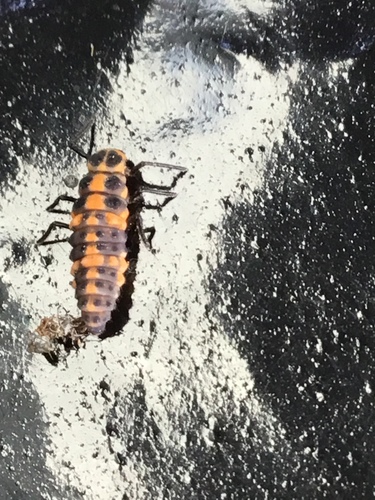
Spotted Lady Beetle © Laura Gaudette
The Spotted Lady Beetle (also known as the Spotted Pink Lady Beetle) is an oblong, pinkish-red lady beetle with a total of twelve black spots on its wing covers. This beetle is native to North America and commonly feeds on aphids, other insect species, and pollen. They are most commonly found among crops that support aphid populations and are most abundant in September.
Status
Native
Conservation status has not been determined in the United States. In Ontario, Canada, Spotted Lady Beetles are considered “Apparently Secure:” at low risk of extinction or population collapse.
Last Seen
2021
Fun Fact
At least one study has shown that planting flowers among aphid-susceptible crops reduces pest density because Spotted Lady Beetles attracted by the flowers’ pollen will also feed on the nearby aphids.
Identification
- Oblong beetle, 5 to 6 mm in length.
- Wing covers are red, pink, or yellowish-orange, with 6 black spots on each wing cover. Two black spots on each individual wing cover appear to connect to opposing spots on the other wing cover when the wings are closed, which makes the beetle look like it has two large central spots on its wing cover seam.
- The pronotum (body part behind the head) is also red or yellowish-orange in color, with two large, triangular black spots.
- The head is mostly black with a red or yellowish-orange triangle in the middle.
- The Spotted Lady Beetle is commonly confused with the Seaside Lady Beetle, Spotted Cucumber Beetle, Parenthesis Lady Beetle, Asian Lady Beetle, and Red Milkweed Beetle.
Habitat
Eats pests and pollen from crops. Frequently visits crops such as wheat, sorghum, alfalfa, soybeans, cotton, potatoes, corn, peas, beans, tomatoes, apples, and other crops attacked by aphids.
General Range
North to Southern Ontario and New England, south throughout the U.S. southern states and west into mid-western states.
Food
Aphids, mites, insect eggs, small larvae, and plant pollen, which may constitute up to 50 percent of their diet. The high percentage of plant pollen in the Spotted Lady Beetle diet is uncommon among lady beetles.
Life cycle
Spotted Lady Beetles can be found from April to October in Vermont. Females lay from 200 to over 1,000 eggs over a one to three month period, beginning in spring or early summer. Spotted Lady Beetles may be the most abundant in September and October as the adults aggregate for mating and preparation for winter hibernation. Spotted Lady Beetles overwinter in aggregations under rocks and leaf litter along hedgerows and protected sites, particularly near crops and other habitats they utilize.
More Information
You can find more information about Spotted Lady Beetles using the links below:
- iNaturalist Species Account
- Bug Guide info page
- Images of their larva can be found here
- Living Atlas Species Profile
Vermont Distribution
Visit the iNaturalist Observation Map and the Occurrence Records to find out where Spotted Lady Beetles have been seen in Vermont.








